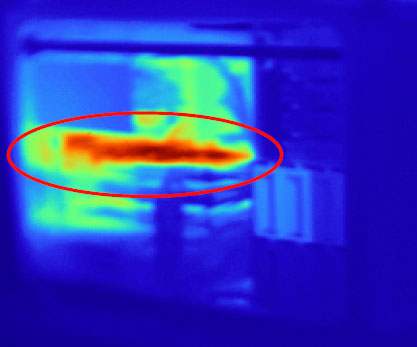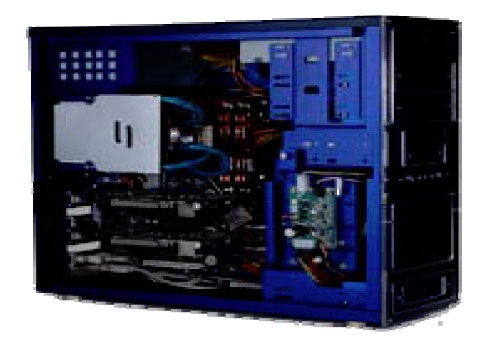NVIDIA Introduces ESA - Enthusiast System Architecture
by Wesley Fink on November 5, 2007 9:00 AM EST- Posted in
- Cases/Cooling/PSUs
ESA Problem Solving
The only limitation to the capabilities of ESA is the imagination of manufacturers, software engineers, and enthusiasts. Perhaps the best way to understand what ESA can potentially do for systems is to look at some current system problems, and how they could be solved using ESA components and tools.

PROBLEM: Airflow in the case is uneven and this affects stability and overclocking capabilities
Causes:

PROBLEM: Poor cooling performance also affects overclocking
Causes: Water Cooling Effectiveness depends on
We would be remiss if we didn't point out a problem that ESA cannot solve: dust and pet hair buildup. However, ESA could tell us our fans are losing efficiency, and we may now look forward to pop-ups telling us we have clogged fans that need cleaning. Obviously, monitoring and control of cooling components can only go so far, but better monitoring at the very least should allow for easier troubleshooting and correction of certain types of problems.
The only limitation to the capabilities of ESA is the imagination of manufacturers, software engineers, and enthusiasts. Perhaps the best way to understand what ESA can potentially do for systems is to look at some current system problems, and how they could be solved using ESA components and tools.

PROBLEM: Airflow in the case is uneven and this affects stability and overclocking capabilities
Causes:
- Insufficient ventilation
- Air blockage in the system
- Poor chassis fan positions/speeds
- Distributed thermal sensors (with 3D position information)
- Instrumented fans that communicate speed and location

PROBLEM: Poor cooling performance also affects overclocking
Causes: Water Cooling Effectiveness depends on
- Flow rate
- Water temperature
- Good thermal connection between blocks and devices
- Monitored water temperature and flow rates
- Controlled fans and pumps
We would be remiss if we didn't point out a problem that ESA cannot solve: dust and pet hair buildup. However, ESA could tell us our fans are losing efficiency, and we may now look forward to pop-ups telling us we have clogged fans that need cleaning. Obviously, monitoring and control of cooling components can only go so far, but better monitoring at the very least should allow for easier troubleshooting and correction of certain types of problems.










28 Comments
View All Comments
Spuke - Monday, November 5, 2007 - link
I'm not getting this until I see some friggin benchmarks. And, to the person that stole my UT3 username, may you rot in hell.johnsonx - Monday, November 5, 2007 - link
I don't know why, but as I read all this the first thing that popped into my head is that a virus could interface to the ESA controls and shut down your fans, fiddle with the voltages, reset all the warning thresholds, and generally screw up your system at a hardware level. This is something that has generally been impossible thus far (despite the various hoaxes about some virus that will destroy your monitor, fry your mainboard, and kill your cat). Hopefully nVidia and friends are considering this possibility as they go forward with this excellent concept.Shortass - Monday, November 5, 2007 - link
Agreed, that would be utterly terrifying if a new Trojan came out that not only screwed up your files and locked you out of your system, but also overvolted all of your components and turned your fans down to 0%. Eeeek.Plasmoid - Monday, November 5, 2007 - link
Sounds nice.Sounds a lot like what Abit have been doing with uGuru for the past 5 years.
Give me the ability to control my fan speed and clock speed by profiles, and change them with a hotkey, and im sold. The rest of the stuff sounds pretty handy too.
xsilver - Tuesday, November 6, 2007 - link
Yes I think abit is the master of this kind of stuff.uguru is the only thing I miss on my old system.
Even new asus boards dont support for advanced monitoring/tweaking abilities.
My main miss is the ability to overclock/underclock on the fly in windows. Ati tool already has a profile scheme where if it detects if a game is being launched it will switch to 3d profile; why does this not exist for CPU's and other components?
yacoub - Monday, November 5, 2007 - link
There are two things that matter a lot when it comes to system monitoring/controlling software:Bloat - How much does it impact system response/performance? How much system resources are taken up running the software?
Interface - Is it small and configurable, or ugly and large like most of this crap when it comes from the OEM instead of a 3rd party user? One thing you'll notice with tools like ATiTool and SpeedFan is that they are designed to be unobtrusive, configurable, and light (from a resources perspective).
Most OEM tools are giant GUIs with a few buttons surrounded by tons of whitespace or ugly, space-wasting colored graphics and pointless clutter that would appeal more to an eight-year-old than an adult. They also tend to be bloated, taking a long time to load and using a lot of system resources just to monitor the system, which is counterproductive.
So until we see how this system rates in those two areas, we don't really have the info we need to make a judgment call as to whether this move by NVidia is progress or regression.
Ryanman - Thursday, November 8, 2007 - link
Given, Im no programmer, but couldn't the "bloat" issue be fixed with a couple different modes or something?You have the full on mode that can render the 3d temperature, monitor all systems, etc. etc. And then when you get in game (surely you could configure the program to automatically notice once your system is being monopolized by an application that needs it and "tone down" to where it's only monitoring CPU/RAM use and a couple temperatures (CPU, GPU, HDD) like Logitech's G15 Programs. Hopefully you won't be overclocking or optimizing while playing crisis.
And a sleek UI isn't that hard to make. Get a graphic designer and a couple UI experts to do it, can't be too expensive. Make the buttons big and some color options and I'll have it running all the time.
I'm personally VERY excited about this. I'm an ATI fanboy but ideas like ESA, trying to unify PC enthusiast use (like, say game consoles) is always a good thing. And people may not care about high-end systems and say this is useless, but one of the fun things about this platform is squeezing as much as possible out of it. Let the games begin.
pugster - Monday, November 5, 2007 - link
I think it would be the first good move by the manufacturers. We can probably get rid of the excessive software bloat by the hardware manufacturers including software included by sound cards, video cards, and motherboards. I don't know about the hardware manufacturers giving up control of their hardware to software tweaks.goinginstyle - Monday, November 5, 2007 - link
I am sorry but this article read like the press release from nvidia this morning. If ESA is all that then why not show us the hardware and software working together today? It just appears to be one more way for nvidia to try to control the desktop. Before you start yelling about open platforms, no company goes through this trouble without expecting something in return. That is why it would be interesting to see how well it works on a nvidia designed board compared to one from asus or msi. If something looks like a fish, smells like a fish, then it usually is a fish and this one might also be full of mercury. We go from the great 8800GT release to this in one week. :(Wesley Fink - Monday, November 5, 2007 - link
As I said in the review Final Words:"One of the frustrations of technology launches, as opposed to actual hardware and software launches, is that no matter what you write it ends up sounding something like a commercial for the product. That is why all the writers at AnandTech much prefer the hard reality of testing a product at launch, where we can make comparisons."
However, ESA is a proposed new standard for communication and control more than a real product. We plann to evaluate an ESA enabled system with as many ESA components as possible as soon it is available. At this point the new ESA chipset itself is not even launched.